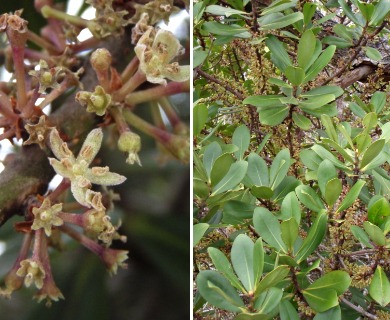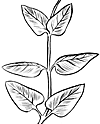Kolea Lau Nui
Myrsine lessertiana
Primrose family (Primulaceae)
Native species ()
Two common and widely distributed species ( lessertiana and sandwicensis) will serve as examples of the Myrsine, of small to medium-sized native trees in which as many as 20 Hawaiian species have been distinguished. In this the leaves generally are many, crowded, narrowly elliptical or lance-shaped and broadest beyond middle, tapering to base and short leafstalk, with -dots visible under a hand lens; many small short-stalked greenish five-parted flowers crowded along twig back of leaves; and many small round, blackish single-seeded (berries).

©2013 Eric White
Leaves many, but crowded, hairless, narrowly elliptical, 3 1⁄4–5 1⁄2 inches (8–14 ) long and 1–1 1⁄2 inches (2.5–4 ) wide, slightly thick and leathery or slightly fleshy, blunt to rounded or pointed, base short- to long-pointed, pink when young, tapering at base to short winged greenish or pinkish leafstalk of 1⁄4 inch (6 ) or almost stalkless, upper surface slightly shiny green with inconspicuous veins, lower surface dull light green with many blackish -dots visible under a lens.
Flowers are many, small, about 1⁄8 inch (3 ) long and broad, in groups of 3–7 on short slender stalks of 1⁄4 inch (6 ) along twigs and short spurs back of leaves and at base of oldest leaves. light green, of five pointed of five elliptical yellowish with red dots; five short stalkless attached on and and with conical and almost stalkless
(berries) are round or elliptical, about 1⁄4 inch (6 ) in diameter, turning from green to reddish or black, with at base and pointed at Seed single, round.
The wood is pinkish yellow with prominent reddish brown providing a prominent figure on all surfaces. It is moderately hard, easily worked and polished, and suitable for cabinet work but not used at present. Used by the Hawaiians as timber for houses and anvils on which to beat tapa. A black dye for tapa was made from the charcoal.
This very variable species is widespread through the islands, especially in wet forests and open areas at 700–4000 ft (213–1219 ) altitude.
Special areas
Haleakala, Volcanoes, Kipuka Puaulu
Champion
Height 67 ft (20.4 ), c.b.h. 6.8 ft (20.7 ), spread 25 ft (7.6 ). Hawaii Volcanoes National Park, Hawaii (1968).
Range
Kauai, Oahu, Molokai, Lanai, Maui, and Hawaii only
Other common name
kōlea
Botanical
Myrsine meziana (Levl.) Wilbur, Suttonia lessertiana (A. DC.) Mez, Rapanea lessertiana (A. DC.) Deg. & Hosaka
Rock noted that this species is one of the most variable in the and that two trees are hardly alike. He reported that red sap exudes from cut trunks and formerly served for dyeing tapa or bark cloth.







